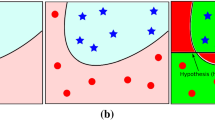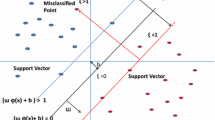Abstract
Pattern recognition and data mining using support vector machine (SVM) have been the focus of widespread researches in recent decades. In SVM, a hyper-plane is designed to classify the training data. A challenge in SVM is that the parameters of hyper-planes are constants. As a result, there may be some critical points that will be classified into a wrong set. It should be mentioned that finding this hyper-plane is very similar to solving a regression problem using parametric or semi-parametric models in statistics. This is the main motivation of this paper. The contribution of this paper is combining SVM classifier and semi-parametric models (SP-SVM) to solve the aforementioned challenge. In fact, using semi-parametric linear model results in some serial linear decision boundaries with several slopes and intercepts. In other words, there are two types of kernels in the proposed SP-SVM: the kernels that perform nonlinear transformation of the input features and the kernels needed in the semi-parametric model. The validations have been done on Iris data set and also some other linearly non-separable classification problems. The accuracy of the proposed SP-SVM outperforms some related algorithms such as K-nearest neighbor (KNN)-based weighted multi-class twin support vector machines (KWMTSVM), support vector classification–regression machine for K-class classification (K-SVCR), twin multi-class classification support vector machines (twin-KSVC), intelligent particle swarm classifier (IPS-classifier) and random forest. The accuracy of SP-SVM is 97.33%. Thus, SP-SVM can play an important role in increasing the accuracy of industrial machines that perform classifications, for example, agricultural products.














Similar content being viewed by others
Explore related subjects
Discover the latest articles, news and stories from top researchers in related subjects.Data availability
The authors confirm that the data supporting the findings of this study are available within the article or its references.
References
Alajlan N, Bazi Y, Melgani F, Yager RR (2012) Fusion of supervised and unsupervised learning for improved classification of hyperspectral images. Inf Sci 217:39–55
Bashbaghi S, Granger E, Sabourin R, Bilodeau GA (2017) Dynamic ensembles of exemplar-svms for still-to-video face recognition. Pattern Recogn 69:61–81
Bertsekas DP (1995) Dynamic programming and optimal control. Athena scientific, Belmont, MA
Bi J, Chen Y, Wang JZ (2005) A sparse support vector machine approach to region-based image categorization. In: Proceedings of the 2005 IEEE computer society conference on computer vision and pattern recognition (CVPR’05), vol 1, pp 1121–1128
Burges CC (1998) A tutorial on support vector machines for pattern recognition. In: Proceedings of international conference on data mining and knowledge discovery, vol 2, no 2, pp 121–167
Byun H, Lee SW (2002) Applications of support vector machines for pattern recognition: a survey. In: Lee S-W, Verri A (eds) Pattern recognition with support vector machines. Springer, Berlin, Heidelberg, pp 213–236. https://doi.org/10.1007/3-540-45665-1_17
Campbell C (2000) An introduction to kernel methods. In: Howlett RJ, Jain LC (eds) Radial basis function networks design and applications. Springer Verlag, Berlin
Caoa LJ, Chuab KS, Chongc WK, Leea HP, Gud QM (2003) A comparison of PCA, KPCA and ICA for dimensionality reduction in support vector machine. Neurocomputing 55:321–336
Christlein V, Bernecker D, Hönig F, Maier A, Angelopoulou E (2017) Writer identification using GMM supervectors and exemplar-SVMs. Pattern Recogn 63:258–267
Downs T, Gates KE, Masters A (2001) Exact simplification of support vector solutions. J Mach Learn Res 2:293–297
Dukart J, Mueller K, Barthel H, Villringer A, Sabri O, Schroeter ML, Alzheimer’s Disease Neuroimaging Initiative (2013) Meta-analysis based SVM classification enables accurate detection of Alzheimer’s disease across different clinical centers using FDG-PET and MRI. Psychiatry Res Neuroimaging 212(3):230–236
Fateh MM, Khorashadizadeh S (2012) Optimal robust voltage control of electrically driven robot manipulators. Nonlinear Dyn 70(2):1445–1458
Garcia MG, Rojo-Álvarez JL, Alonso-Atienza F, Martínez-Ramón M (2006) Support vector machines for robust channel estimation in OFDM. IEEE Signal Process Lett 13(7):397–400
Gu B, Sheng VS (2017) A robust regularization path algorithm for -support vector classification. IEEE Trans Neural Netw Learn Syst 28(5):1241–1248
Gunn SR (1998) Support vector machines for classification and regression, University of Southampton
Gutschoven B, Verlinde P (2000) Multi-modal identity verification using support vector machines (SVM). In: Proceedings of the third international conference on information fusion, pp 3–8
Haddi Z, Alami H, El Bari N, Tounsi M, Barhoumi H, Maaref A, Jaffrezic-Renault N, Bouchikhi BE (2013) Electronic nose and tongue combination for improved classification of Moroccan virgin olive oil profiles. Food Res Int 54(2):1488–1498
Haykin S (1999) Neural networks. Prentice Hall Inc, USA
Haykin S (2007) Neural networks: a comprehensive foundation. Prentice-Hall Inc
Hesamian G, Akbari MG, Asadollahi M (2017) Fuzzy semi-parametric partially linear model with fuzzy inputs and fuzzy outputs. Expert Syst Appl 71:230–239
Izquierdo-Verdiguier E, Gomez-Chova L, Bruzzone L, Camps-Valls G (2013) Semisupervised kernel feature extraction for remote sensing image analysis. IEEE Trans Geosci Remote Sens 2(9):5567–5578
Kuo B, Ho H, Li C, Hung C, Taur J (2014) A Kernel-based Feature Selection Method for SVM with RBF Kernel for Hyperspectral Image Classification. IEEE J Select Top Appl Earth Oobserv Remote Sens 7(1):317–326
Liu Y, Wen K, Gao Q, Gao X, Nie F (2018) SVM based multi-label learning with missing labels for image annotation. Pattern Recogn 78:307–317
Moghaddam VH, Hamidzadeh J (2016) New Hermite orthogonal polynomial kernel and combined kernels in Support Vector Machine classifier. Pattern Recogn 60:921–935
Osuna E, Freund R, Girosi F (1997) Training support machines: an application to face detection. In: Proceedings of IEEE conference on computer vision and pattern recognition, pp 130–136
Ozer S, Chen C, Cirpan HA (2011) A set of new Chebyshev kernel functions for support vector machine pattern classification. Pattern Recogn 44:1435–1447
Roy A, Singha J, Devi SS, Laskar RH (2016) Impulse noise removal using SVM classification based fuzzy filter from gray scale images. Signal Process 128:262–273
Sapankevych, N. I., & Sankar, R. (2009). Time series prediction using support vector machines: a survey. IEEE Computational Intelligence Magazine, 4(2).
Shah JH, Sharif M, Yasmin M, Fernandes SL (2017) Facial expressions classification and false label reduction using LDA and threefold SVM. Pattern Recogn Lett. https://doi.org/10.1016/j.patrec.2017.06.021
Siswantoro J, Prabuwono AS, Abdullah A, Idrus B (2016) A linear model based on Kalman filter for improving neural network classification performance. Expert Syst Appl 49:112–122
Solera-Urena R, García-Moral AI, Pelaez-Moreno C, Martinez-Ramon M, Diaz-de-Maria F (2012) Real-time robust automatic speech recognition using compact support vector machines. IEEE Trans Audio Speech Lang Process 20(4):1347
Song Q, Hu W, Xie W (2002) Robust support vector machine with bullet hole image classification. IEEE Trans Syst Man Cybern Part C (applications and Reviews) 32(4):440–448
Steinwart L, Schölkopf SB (2004) Sparseness of support vector machines--some asymptotically sharp bounds. Adv Neural Inf Process Syst 16
Subasi A (2013) Classification of EMG signals using PSO optimized SVM for diagnosis of neuromuscular disorders. Comput Biol Med 43(5):576–586
Tanveer M, Sharma A, Suganthan PN (2021) Least squares KNN-based weighted multiclass twin SVM. Neurocomputing 459:454–464
Vapnik V (1995) The nature of statistical learning theory. Springer
Wasserman L (2006) All of nonparametric statistics. Springer, New York
Wu Y, He J, Ji Y, Huang G, Yao H, Zhang P, Wen Xu, Guo M, Li Y (2019) Enhanced classification models for iris dataset. Procedia Comput Sci 162:946–954
Ye R, Suganthan PN (2012) A kernel-ensemble bagging support vector machine. In: 12th international conference on intelligent systems design and applications (ISDA), pp 847–852
Zadeh SMH, Khorashadizadeh S, Fateh MM, Hadadzarif M (2016) Optimal sliding mode control of a robot manipulator under uncertainty using PSO. Nonlinear Dyn 84(4):2227–2239
Zahiri SH, Seyedin SA (2007) Swarm intelligence based classifiers. J Franklin Inst 344(5):362–376
Zarei R, Akbari MG, Chachi J (2020) Modeling autoregressive fuzzy time series data based on semi-parametric methods. Soft Comput 24(10):7295–7304
Zhang L, Zhou W, Jiao L (2004) Wavelet support vector machine. IEEE Trans Syst Man Cybern Part B 34(1):34–39. https://doi.org/10.1109/TSMCB.2003.811113
Zhu F, Wei J (2017) Localization algorithm for large scale wireless sensor networks based on fast-SVM. Wireless Pers Commun 95(3):1859–1875
Acknowledgements
Authors declare that the manuscript has not been submitted to more than one journal for simultaneous consideration and it has not been published previously (partly or in full). In addition, this study has not been split up into several parts to increase the quantity of submissions. No data have been fabricated or manipulated to support the conclusions. Moreover, no data, text or theories by others are presented as if they were our own. Proper acknowledgements to other works have been given.
Funding
No organization has funded this study.
Author information
Authors and Affiliations
Contributions
MGA developed the main ideas, generated the formulation of the algorithm and performed the experiments. SK provided the English text of the paper, edited the formulations and simulations, provided the reply letter and revised the manuscript. MM provided the references for literature review and proposed some experiments.
Corresponding author
Ethics declarations
Conflict of interest
The authors declare that they have no conflict of interest.
Human or animals rights
Authors declare that there has been no human participant or animal in this research.
Informed consent
Authors declare that there is no need for informed consent for this paper, since the results have been obtained using computer simulations.
Additional information
Publisher's Note
Springer Nature remains neutral with regard to jurisdictional claims in published maps and institutional affiliations.
Rights and permissions
Springer Nature or its licensor holds exclusive rights to this article under a publishing agreement with the author(s) or other rightsholder(s); author self-archiving of the accepted manuscript version of this article is solely governed by the terms of such publishing agreement and applicable law.
About this article
Cite this article
Akbari, M., Khorashadizadeh, S. & Majidi, MH. Support vector machine classification using semi-parametric model. Soft Comput 26, 10049–10062 (2022). https://doi.org/10.1007/s00500-022-07376-2
Accepted:
Published:
Issue Date:
DOI: https://doi.org/10.1007/s00500-022-07376-2




